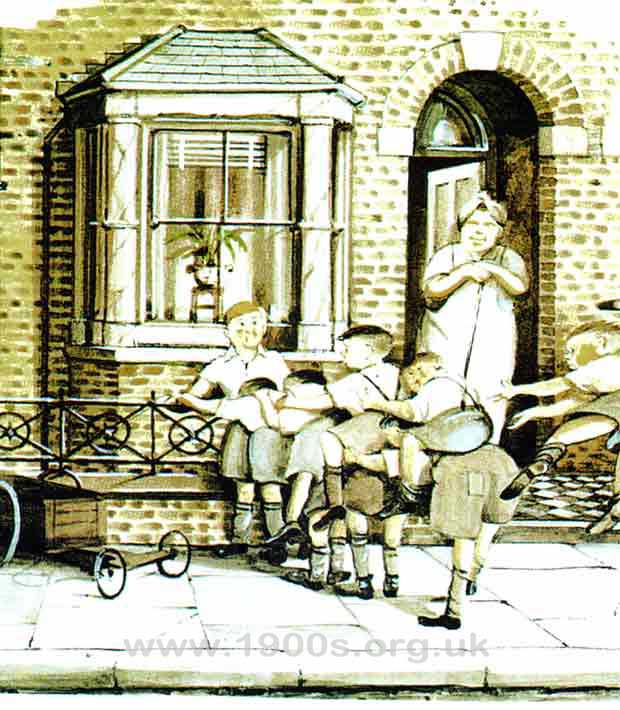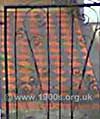
The front facades of houses on typical Victorian housing estates
This page describes the front facade of typical terraced houses on housing estates that were typical of those that sprang up across the UK in late Victorian times. A feature is what happened to the iron railings that fronted such facades and were removed in the Second World War. The page is one of a series on details of such houses - see the above menu.
____
By the webmaster's mother (1906-2002) from firsthand recollections, edited with further research by the webmaster
The approach to the house
In the early 1900s, the approach to my family's house on its Victorian housing estate was much the same as the approach to any other house on any other such estate anywhere in the country
The following sketch of the front facade is impressive for its accurate details. Note, in particular the following descriptions:

The front facade of an early 1900s terraced house
The game that the boys are playing is described on a separate page.
The garden railings
The garden railings shown in the sketch were typical across the entire country for these Victorian and Edwardian estates. They can just be seen on any number of photos on this website, but if you would prefer a larger image, you may like to check out the example of railings design on a quite ordinary house which happens to be in the midlands.
Yet these beautiful railings are nowhere to be found today. In 1943 they were all removed, because steel was needed for the Second World War effort. They were never replaced.
What became of the iron railings?
Sad to say a great deal of evidence has emerged that most of the collected iron was never used. Apparently more was collected than required and it was the wrong quality. I understand that the Government of the Day didn't dare admit to the mistake and deposited the railings in rivers in the dead of night. The speculation is that many of these beautiful artifacts are still lying rusting in the Thames.
Neil Cryer
Stumps from where railings were sawn off can still be seen in old pavements.
The front path
The path up to the front door was made of dark red and dark grey diamond-shaped tiles. It is just visible in the sketch which is accurate in its detail of the shape and pattern on the tiles.

The front path of a similar house which still has its original Victorian tiles.
The front porch
The front porch was inset into the house and it was just the right size to keep people out of the weather while dipping into bags to find a front door key.
The front door
All the front doors along the roads in the estate were grained and varnished and the paintwork was kept in good repair. They all had two panels of patterned frosted glass.
These doors gave a pleasing uniformity to the road which was thanks to the owner of the estate, as the houses were rented, making the external upkeep the responsibility of the landlord.
On the inside of the door was a string, attached to the knob and draped along just below the letter box to a hook so that we children who hadn't a door key could just put our hand inside the letterbox and pull the string to open the door - a device no-one would dare to have in later years.
The front garden
The front garden was the one feature that could be different from house to house because the landlord allowed residents to plant it as they wished.
Front gardens were very small. Ours had an evergreen shrub round the window, a creeper that reached up to the bedroom window and a privet hedge that faced the road behind garden railings. Keeping the hedge in good shape was one of the jobs that my father allowed me to take over when I was able to manage the shears.
The windows
Sash windows was the name of the style of the windows. These were the easily the most common in all the buildings of the time, not just the Victorian housing estates. Note the venetian blinds at the window of the sketch and the aspidistra on the window sill.The hall/passage
Just inside the front door was the hall, known as the passage which is just visible in the sketch. There was a rack there to hang coats and a small umbrella stand. There was a very nice hall lantern hanging from the ceiling.
If you can add anything to this page or provide a photo, I would be pleased if you would contact me.
Text and images are copyright
sources: early 20th century material
sources: ww2 home front and other material
contact
the webmaster/author/researcher/editor
privacy policy
















